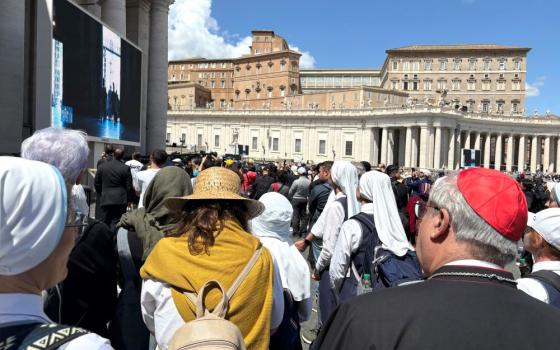"The bone usually breaks in a similar way."
The chaplain raises his arm and runs a finger from his elbow to wrist.
"Her arm gets twisted. Often fractures along the same path."
In a hospital corridor, the chaplain prepares me for a first pastoral visit to the ER. I cringe as he describes the epidemic of women treated for domestic violence in our hospital emergency rooms.
Of course, not every arm gets broken. Teeth crack. Thighs bruise. Eyelids swell shut.
The images haunt me. Even now, they loom alongside other images I encounter in the news. On my computer screen, I watch kidnapped Nigerian girls huddle next to Hollywood's "hottest summer bods." Side by side, the two headlines glow together. They always seem to glow together. Recent gang rapes and Kate Middleton's iconic summer fashion. Child brides and flashing Botox ads.
We are numbed out. Headlines scream even as we cannot. Even as a young woman chokes back tears: "I don't know what to do! He claimed I was asking for it. No one can ever find out."
How many stories can no one ever find out? Fondles stolen by family members, acquaintances and friends. The church's sex abuse crisis. Surely not our Catholic teens in abortion clinics.
Dare to listen to the stifled cries beneath our headlines, to the stories of violence, silent in families, churches and schools.
I count my sisters as they pass: two, four, six -- every sixth American woman experiences rape or attempted rape. Globally, countless more suffer from a range of male violence that kills or injures more women between 15 and 45 years of age than cancer, malaria, traffic accidents, and war combined.
"Male violence? Does it really specify male violence?"
It does. And yes, not all men are violent. Guys can be tremendous allies for women. Committed supporters. Prophetic advocates. That said, we need even more because the statistic hasn't changed yet. Gender-based violence persists as the top public health crisis threatening women today.
Of course, physical harm is only part of the story. Largely normalized and unseen, violence against women surfaces in an insidious variety of forms: gender pay inequality, sexist jokes and advertising, Photoshopping, pornography, the list goes on. It also reveals our national and ecclesial obsession with the female body and its rights and limitations in matters ranging from birth control to abortion to homosexuality.
"Why?" my students ask. "Why is it like this?"
My heart aches every time the question rises in class. It surfaces as students grapple to understand why Hagar was sent to die after bearing Abraham's child. Why Lot offered his own daughters to be raped. Why violence against women cuts through the Bible, across centuries and onto our bodies today.
"Why? Why is it like this?" The question is a crying out; this grief, a first step toward healing.
Tend gently the pain. Even in darkness, when we feel most alone. Even here, we can discover: our tears can steep us in hope for a different world -- of another way possible, though not easy. Not easy at all.
Gender-based violence is far more complex than any "battle of the sexes" or "war on women." It afflicts a human community fearful of its own daughters, of the power in our flesh and the gift of a woman's intellect, spirit, and voice.
Even now, we grapple with this fear, with knowing, at some level, that to embrace a woman's human dignity is to participate in the crumbling of an old age. It demands no less than our shedding of entrenched attitudes, value systems, and a very consciousness that denies the full humanity of women -- and men.
Yes, men too. Such violence is fueled by suffering fathers and brothers, by our sons whose masculinity is often measured by their capacity to dominate, to repress their emotional and relational needs.
"We've got to act tough," teen boys have confided to my female students. "If a guy shows too many feelings, he gets called a fag."
Without doubt, the plague of gender-based violence threatens us all. We each hold the challenge and possibility of a new chapter in our human story. So too does our church.
The Catholic community bears a unique, even sacred responsibility for denouncing the sins of violence and sexism. This responsibility is rooted in Jesus' liberating witness and the prophetic demands of Christian discipleship. As the people of God, we are called to the forefront of the human struggle for freedom, a struggle epitomized in the suffering of women. In confronting gender-based violence, our efforts must begin with an eradication of its presence in our church itself.
Indeed, this challenge is being faced by many courageous women and men, lay and religious alike. Still, however, our church suffers from an institutionalized silence and inaction that enables, even condones, violence against women. One need only look at the church's sex abuse crisis for a searing example.
We must dare to ask the tough questions. How, for instance, does our fear of the feminine face of God devalue God's beauty in the women and girls we love most? In what ways does this devaluation appear in our families, parishes, schools and ecclesial structures? As Pope Francis highlights, our church suffers greatly from the poverty of an "incisive female presence." How does this poverty, particularly in our hierarchy, sanction a climate that denies the holy gifts and dignity of women? Sadly, it is in such an environment that violence against women becomes more easily acceptable.
Our church desperately needs creative, courageous action. In a spirit of prayerful discernment, we must consider: What constitutes a faithful response, both individually and collectively?
Many questions remain to be asked. No easy answers are guaranteed.
Even so, we must risk a first step on the journey. Trust each question enough to follow it, one step forward and then another. Only then can we forge a more authentic way of being -- female and male, a human community together.
[Jennifer Mertens will graduate in August with her Master of Divinity from the Catholic Theological Union. She teaches religion at a Catholic high school in Cincinnati.]
Editor's note: We can send you an email alert every time a Young Voices column is posted to NCRonline.org. Go to this page and follow directions: Email alert sign-up.


